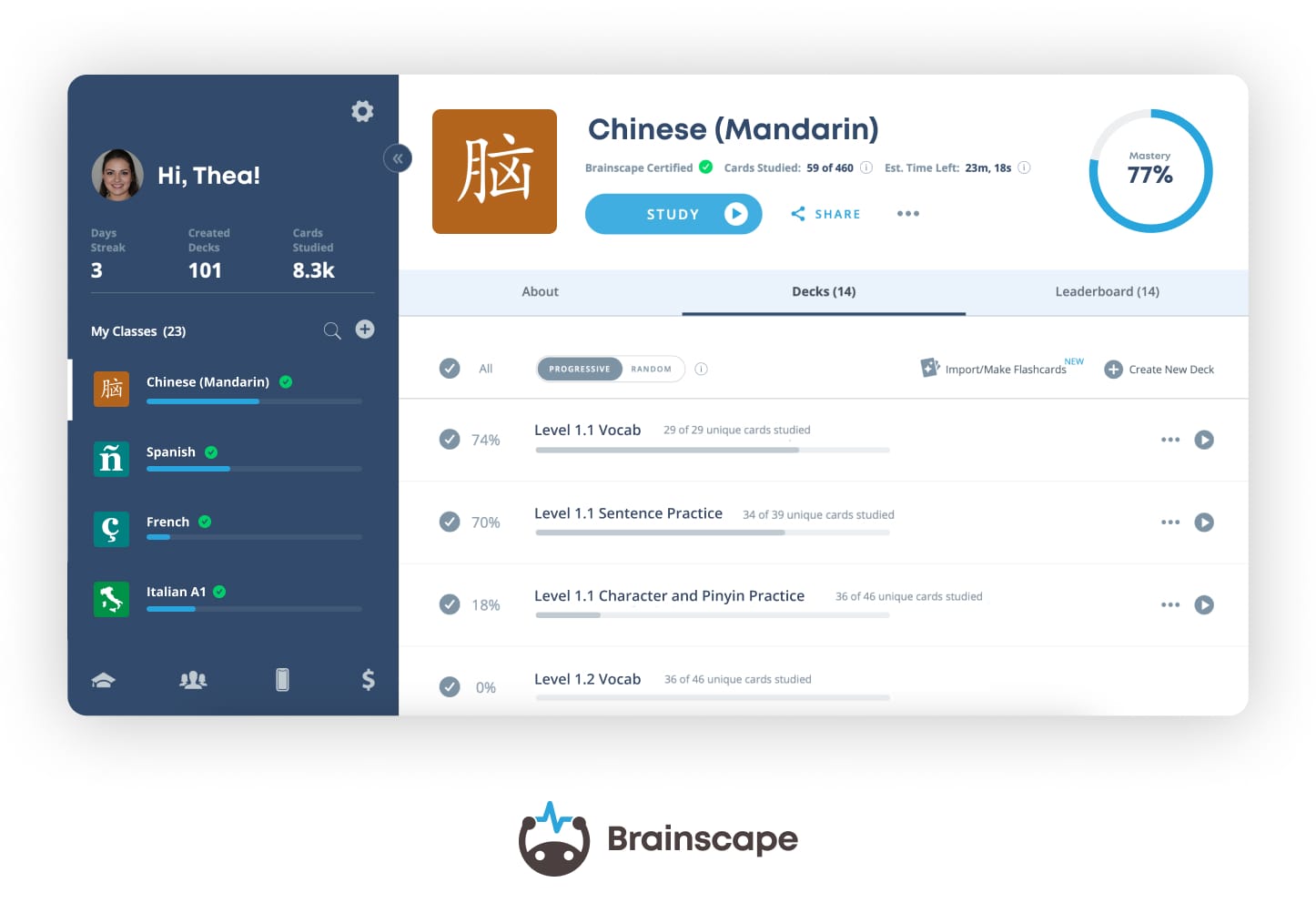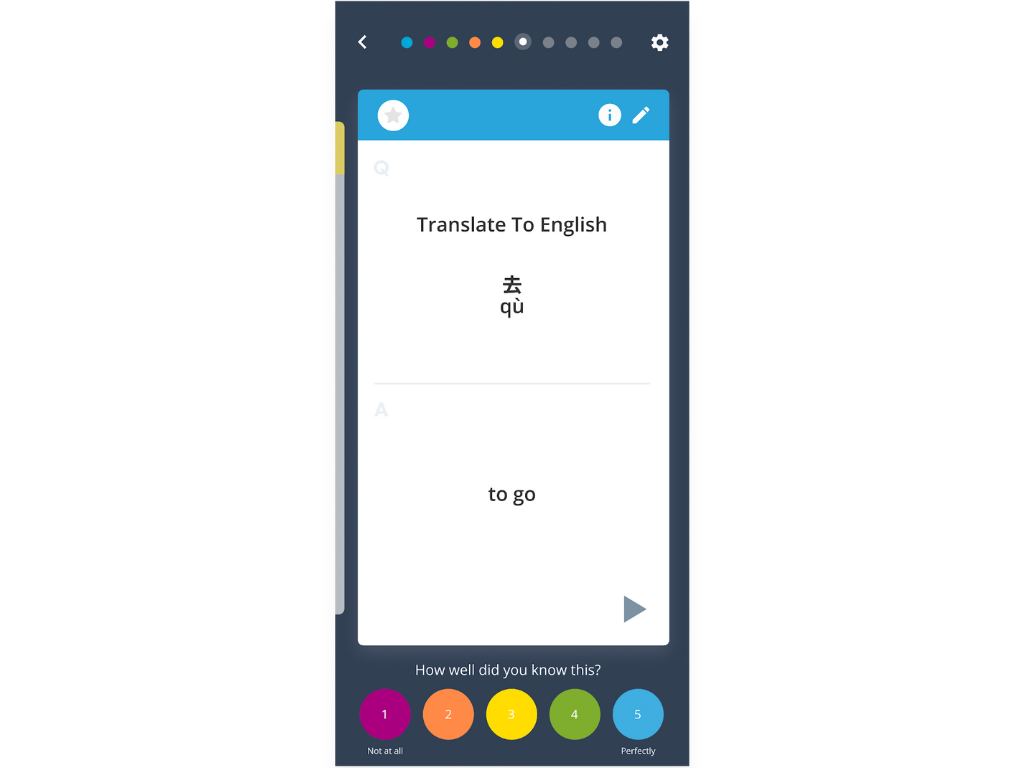It’s one of the most widely-spoken languages in the world with a beguiling, millennia-long history. We’re talking, of course, about Chinese. With China’s skyrocketing economic prowess, it’s little wonder that so many people are taking an interest in learning Mandarin, spoken by over 1 billion people worldwide.
The thing is, Chinese is a pretty difficult language to learn unless you approach it with the right tools. And so, the learning nerds at Brainscape put together this complete toolkit of apps to learn Chinese, focusing on:
- Learning (and remembering) vocabulary and commonly-used phrases,
- Practicing writing characters, pronouncing words, and compiling sentences, and
- Developing your reading, writing, and listening skills.
So, if you’ve embarked upon your Mandarin-learning journey (or are about to), here are the best Chinese apps in 2025, starting with our personal favorite (because we’re just a smidge biased) … Brainscape!
Best Chinese Apps # 1: Brainscape
Efficiently Learn & Memorize Chinese Vocabulary, Grammar, & Characters
Brainscape is a web and mobile app that has been engineered to help students learn (and remember) common Mandarin vocabulary and grammar TWICE as fast as traditional study techniques. The app boasts over 4,450 flashcards (and 2,000 audio flashcards) covering the most common Chinese words, phrases, and sentence constructions, and a carefully tailored curriculum that builds on previous concepts, guiding you from beginner to conversational at your own pace.
Get Brainscape’s certified Chinese flashcards here.

The brain is hardwired to learn and remember information through repeated exposure. Brainscape’s flashcard app leverages this hardwiring to help students learn as fast and painlessly as humanly possible. The app’s “secret sauce” is a learning algorithm that delivers information to your brain in a way that optimizes its ability to retain that information.

Other super useful features include:
- An adaptive, spaced repetition system called Confidence-Based Repetition;
- Ongoing feedback, statistics, and visualization tools to help users track their progress;
- A network of thousands of other learners who support each other's learning every day;
- A library of helpful, informative articles to motivate your learning journey;
- Simple explanations for key grammatical concepts and the most common verb conjugations;
- Easy access to study online (or offline, once you have downloaded a deck or class) or in Brainscape's mobile apps.
So, if you want to learn Chinese fast and efficiently, with the convenience of an app you can use anytime, anywhere, and on any device—even offline—the best Chinese app in 2025 (and beyond) is Brainscape.
Also, make sure you go into learning Chinese with the right mental formula!
Best Chinese App # 2: HelloChinese
Kick off Your Education by Learning Pinyin
Targeted at beginners, HelloChinese is a fun app that guides users from not being able to speak a single word of Mandarin to conversational fluency, while exploring Chinese culture along the way.
HelloChinese starts with an explanation of how to read Pinyin—the written form of Mandarin that uses Roman letters instead of Chinese characters—and from there, slowly builds knowledge, skill, and confidence.
The app features:
- Game-based learning, which keeps users motivated and engaged;
- Immersive lessons to help you have real-life, practical conversations quickly;
- 2,000+ Videos featuring authentic Chinese speakers;
- Adaptive learning games colored with Chinese cultural education;
- Speech recognition that helps you to perfect your pronunciation; and
- A curriculum of systematic courses based on HSK levels;
Best Chinese App # 3: Skritter Chinese
Learn to Write Chinese Characters
To learn Mandarin, you need to read and write its characters, which is where Skritter Chinese comes in. Most other apps only teach you to recognize characters, but this app teaches you how to write over 10,000 characters, one stroke at a time.
First, you learn a character’s meaning, reading, and tone. Then you practice writing it. These characters can then be combined in various ways to write 400,000+ words.
Best Chinese App # 4: LingoDeer
Practice Your Reading and Writing Skills
LingoDeer is a well-structured, gamified Chinese language app that teaches vocabulary and grammar from HSK 1 to HSK 3, as well as the 1,000 most commonly used and important Chinese characters.
The app relies on very little English, which pushes you to start thinking in Mandarin (a powerful motivator for efficient learning). Lessons are broken down into practical, logically-ordered themes, covering a variety of exercises to keep you engaged. Most of the content covers new vocabulary and grammar intuitively but also includes direct textbook-style explanations and detailed grammar notes if you’re unclear on something. You also get a breakdown of your performance after each lesson so that you can work on your weaknesses.
Other features include character-writing practice (the app boasts a handwriting recognition system); speaking practice by listening to native speakers in slow motion and then recording yourself; and audio- and video-based quizzes.
Best Chinese App # 5: HSK Online AKA SuperTest
Assess Your Progress and Skill with Standardized Online Tests
HSK (Hanyu Shuiping Kaoshi) is a standardized test (both written and online) used to measure a speaker’s skill in Chinese. It consists of various levels, with increasingly large and more complex vocabularies, ranging from the essentials at HSK 1 all the way to fluency at HSK 6.
Accompanying the tests are curated lesson plans to improve your listening, reading, and writing skills. Essentially, if you want to study in a Chinese university or work in a Chinese company, this is the test used to measure your language proficiency!
Best Chinese App # 6: Pleco Chinese Dictionary
Look up Words and Fill in the Gaps in Your Understanding
Pleco Chinese Dictionary is a convenient and essential pocket reference tool for learning any language. This is especially true of Chinese Mandarin, because even if you’ve been studying it for years, you’re still going to come across new characters and words. This is where the sophisticated Pleco Chinese Dictionary app comes to the rescue.
Like a regular dictionary, Pleco provides the definition and pronunciation of new words, as well as how to use them in a sentence. But it also allows you to break words down so that you can (1) understand their derivations and (2) study the individual character components that go into their construction.
When searching for a word, this Chinese dictionary app accepts Pinyin, drawn characters, photos of Chinese characters (on a menu, for example), or the English equivalent.
Best Chinese App # 7: Du Chinese
Color Your Language Learning (and Accelerate Your Reading Skill) with Popular Chinese Stories
Du Chinese helps you practice Mandarin through speaking and reading. It teaches you Mandarin through stories, which improves your vocabulary, character recognition, pronunciation, and reading comprehension.
It’s important to study individual words, characters, and phrases on a flashcard app like Brainscape, but tying them all together into flowing language is where real conversational fluency begins. Du Chinese (which means “to read” Chinese) helps you accomplish this through reading literature and listening to stories, which have been written and recorded by native Mandarin speakers and accompanied by professional translations.
Each story is marked with the appropriate HSK level:
- Beginners (HSK 1 and 2) start with really simple, fun stories with basic vocabulary,
- Intermediate speakers (HSK 3 and 4) get longer, more complex stories with a stronger focus on grammar, and
- Advanced learners (HSK 5 and 6) get real classical Chinese texts, such as literature from the Tang Dynasty, the golden age for Chinese arts and culture.
Best Chinese App # 8: Standard Mandarin
Learn to Properly Pronounce and Sound Out Chinese Words
You could learn to read and write fluently in Mandarin, but communication will continue to elude you unless you learn to speak the language with the right pronunciation. And while many of the top Chinese apps we’ve discussed thus far do address pronunciation, none zoom in quite as much on how to get it right as Standard Mandarin.
Standard Mandarin breaks down each sound in Chinese, complete with drills and actual animated diagrams on how to move your mouth, tongue, and even facial muscles to sound out the word correctly. Just choose the sound you want to hear (which is written in Pinyin), and you’ll be presented with information and images for all the different tones for that sound. It’s totally worth it if you’re tired of getting weird looks from the people you’re trying to communicate with.
In Conclu—Wait a Minute, What About Duolingo?
Right, of course you want to know about how DuoLingo measures up to the other Chinese apps on our list. I mean, they’re probably one of the best-known language apps on the market, which is why it feels weird to have come this far without talking about them.
What DuoLingo does is essentially transform language learning into a simple, addictive game. You take courses, which are divided into a suite of topics, beginning with elementary words and sentences (like greetings), progressing through more complicated themes like travel and business. Each new course unlocks new vocabulary and random short sentences that are directly related to the topic covered. You also need to pass gamified challenges in order to unlock higher levels, with the end goal being to unlock an entire “tree” of hundreds of courses.
All of this makes Duolingo a fun way to learn Chinese, and it’s an excellent adjunctive tool to use with Chinese language apps like Brainscape (and the others we’ve mentioned). So, why haven’t we included it near the top of our list?
DuoLingo delivers its lessons and content in a linear fashion without systematically repeating the vocabulary, characters, sentences, and pronunciation you’ve covered in previous lessons. Without repetition and practice, you’re just going to forget everything as you progress.
In fact, to quote the author of the article, I Completed DuoLingo Chinese. Here’s Why You Shouldn’t:
“That summer I spent so much time using the app that I actually completed the DuoLingo Chinese tree. Yet by the end of the summer I not only wasn’t fluent, my spoken Chinese was no higher than a lower elementary level or A1 – the lowest rung on the European framework.”
Another issue with DuoLingo is that many of its practice sentence constructions are straight-up nonsensical. DuoLingo claims that this helps the concepts stick in your brain, but learning sentences like “The Tuesday is similar to the Monday” doesn’t seem like an intuitive way to go about it.
In summary, Duolingo is a master of motivating users to engage with it and feel like they achieved something. The owl is cute, but without repetition and conversational practice, you aren’t really going to be able to speak Chinese by the end of it.
Some Final Advice on Learning Chinese
So, there you have it! Our very best apps to learn Chinese in 2025. We should know what to look for in a language app; after all, Brainscape started as one! So, we’re super nerdy about the cognitive science of acquiring a new language and what the brain needs in order to do that more efficiently.
This brings us to a final thought we’d like to share with you on what it takes to learn a language like Chinese, which is notoriously difficult for Westerners. You see, you can equip yourself with all of these Chinese apps and resources… but the real “secret sauce” to learning Chinese (or any language for that matter) is:
- Building a daily study habit, and
- Finding a powerful motivation for learning.
Learning a language requires a little bit of studying and practice every day for months and sometimes years. Having that strong motivation is what’s going to help you persevere on the days when things get hard, repetitive, or discouraging, as they most certainly will (because learning a language is a marathon).
That’s why, in addition to the top Chinese apps we’ve mentioned in this article, we’d also like to share with you these fundamental resources to help you achieve success:
- Brainscape’s study guide: How to learn Chinese more efficiently
- Your complete toolkit: The best way to learn a language online
- Brainscape’s certified Chinese Mandarin flashcards.
Armed with Brainscape, the ultimate steady weapon, and a powerful motivation to learn Chinese, you’ll have what it takes to speak, read, write, and listen fluently!
